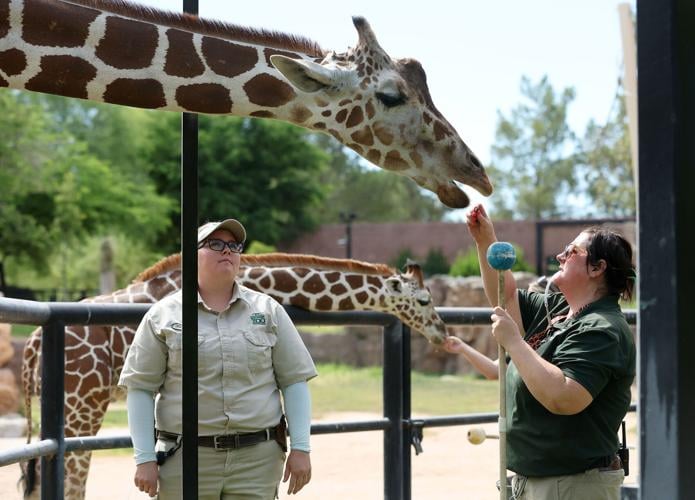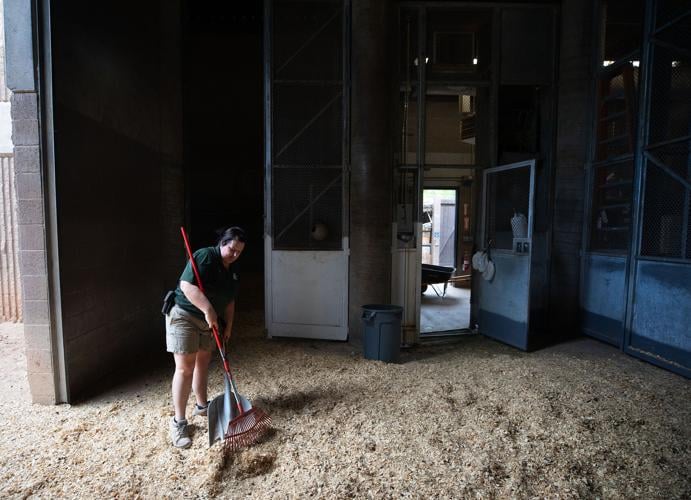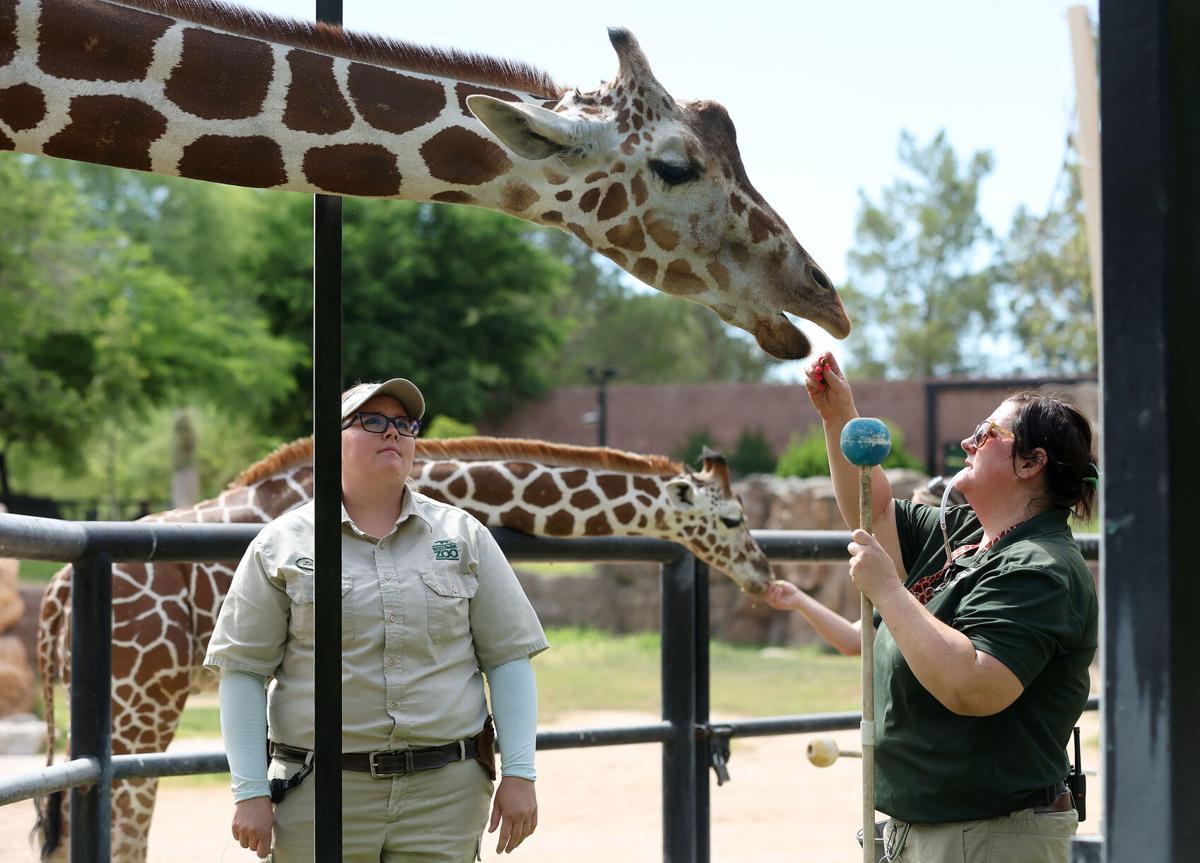Jessica Ranney starts every weekday morning the same way: she says good morning to her friends Penny, Jasiri and Moyo.
Her friends are significant figures in Tucson — both in literal size and community importance. You may know them as the family of giraffes at Reid Park Zoo.
Ranney is the lead hoofstock zookeeper and for the last four years, she has helped care for the zoo’s herd of giraffes including baby giraffe Moyo, Pfeiffer the African spotted-necked otter and a whole gang of meerkats.
“I just like coming in in the morning and seeing the animals and telling them ‘good morning,’” she says. “I really like doing training with the animals because you get that one-on-one time and that special relationship between you and the animal.”
Throughout the winter months, Ranney’s day usually starts around 7 a.m., but by June, her days get an even earlier start because of the summer temperatures.
After greeting her assigned zoo residents, she heads to a morning meeting with multiple zoo departments, including grounds and maintenance. They discuss everything from maintenance needs to updates on animal medication to anything interesting going on at the zoo that day — such as a reporter coming to shadow a zookeeper, she says. 😉
By the time Ranney finishes up her morning meeting, she’s ready to head over to the animals.

Lead zookeeper Jessica Ranney cleans the enclosure at the giraffe care center at Reid Park Zoo.
What it's like inside that very tall giraffe enclosure
With her hair partially pulled back in a green clip, sunglasses on, a purple fanny pack around her waist and a walkie-talkie on her hip, Ranney starts at the giraffe care center, or the “barn” as the zookeepers call it.
At first glance, the center looks industrial with its large metal gates — but when you take another look around, you’ll find hints of love and care for the animals.
There are homemade puzzle feeders made from jugs, Kong toys that can be filled with bananas and other treats as a form of enrichment and a drawing of a mom and baby giraffe from a local child that says, “Congratulations Reid Park Zoo on your baby giraffe. So excited for your keepers and giraffe family.” The giraffe team loved the drawing so much that they laminated it and hung it on the fridge in the center.
Ranney grabs a shovel and heads over to one of the center’s four stalls. In the window stall, where curious kids can peek in to get a glimpse at the animals, male giraffe Jasiri is pacing while periodically glancing outside as mama Penny and four-month-old baby Moyo enjoy the fresh morning weather.
Most of the stall floors are covered with a pile of tan pine shavings sprinkled with giraffe droppings. Yep, just like your smaller furry friends, even giraffe droppings need to be picked up.
Ranney scoops piles of the droppings into a wheelbarrow and drops off the pile in the bed of a zoo utility vehicle. She walks back into the stall and begins raking up the dirty pine shavings so she can replace them with a fresh block.
As she rakes up the dirty shavings and spreads out the new block, dust particles fly everywhere, but Ranney isn’t fazed.

Lead zookeeper Jessica Ranney spreads out fresh pine shavings inside the giraffe care center at Reid Park Zoo.
“Each giraffe can have their own comfy spot to sit and rest,” she says. “(But) giraffes don’t spend a lot of time sitting down. Think about in the wild, they’re such big animals that if they’re sitting down they can be vulnerable to predators.”
While in the stalls, Ranney also removes the browse, which is vegetation like branches from mesquite trees, and replaces them with fresh branches and leaves. Branches from mulberry trees are the giraffes’ favorite, Ranney says. (Don’t worry, rarely any of the browse goes to waste. Most of the time, it goes to the elephant enclosure for the elephants to enjoy since they will eat more than just the leaves.)
“In a zoo setting, we only have so many resources, there are so many trees out there, but they do get a lot of browse here,” she says. “I worked at a zoo in Wisconsin for quite a while with giraffes and we had to be a little more creative. Obviously in the winter, all the trees lose their leaves, so I actually started freezing some browse and then thawing it out. But it’s not nearly enough as the fresh browse here.”
With one stall clean, Ranney moves to the neighboring stall to repeat the process. Once two of the stalls are clean, she closes the gate and locks it up for the safety of the giraffes and the zoo staff.
With the flick of a switch, the gates to the hallway that leads to the stalls open up. Jasiri struts through as he makes his exit to sunshine in the side yard of the care center.
Once Jasiri is out of the windowed stall, Ranney makes her way inside to freshen up the area with a power wash. Between each cleaning session, she takes a swig from her blue water bottle adorned with animal stickers and replies to her colleagues on her walkie-talkie.
“A lot of our job is cleaning,” she says.
Ranney estimates that the daily cleaning routine for the giraffe stalls takes around an hour and a half to complete.

Lead zookeeper Jessica Ranney power washes one of the enclosures in the giraffe care center at Reid Park Zoo.
After cleaning the stalls, Ranney picks up a big blue IKEA bag, heads over to a shed in the care center and grabs a bag full of alfalfa hay — a vibrant green hay that’s softer than other hays.
She stuffs the hay into metal containers in the stalls and hoists them up to the perfect heights for the giraffes. Moyo’s is a little shorter since he’s still a baby — but he’s currently an 8-foot, 400-plus-pound baby.
Jessica Ranney works with more than just giraffes — the otter comes next
Following some time in the giraffe area, Ranney makes her way toward a different enclosure to check on Pfeiffer, the zoo’s geriatric otter. She heads to the back area and reappears in the habitat donning a face mask to help prevent the spread of diseases that Pfeiffer could pick up due to her age.
Before she releases Pfeiffer into her habitat, Ranney places down a puzzle feeder filled with ground fish and topped with stones. It's used as a form of enrichment for Pfeiffer's breakfast. Currently, Pfeiffer’s favorite fish is salmon.
“Otters in general like to manipulate things with their paws, so she is very playful,” Ranney says. “She likes playing with bamboo and rocks and pinecones.”
Once released into the habitat, Pfeiffer makes a beeline for the puzzle feeder and follows her meal with a couple laps in the pool.
Now that Pfeiffer is swimmingly happy, Ranney makes her way back to the giraffe enclosure to engage in a target training exercise with Penny and Moyo. Training sessions at the zoo are used to check on the well-being of the animals and help them become familiar with movements a veterinarian might need.
Zoo vet tech Amanda Willits meets with Ranney outside the giraffe care center to begin the training. Ranney walks to the edge of the enclosure and uses a target tool to grab Penny’s attention. The tool looks like a giant lollipop.
As she moves the tool around, Penny follows along and touches the target with her nose, which earns her a treat and a “good” from Ranney.
“I would have her target (touch the tool) and then I would say ‘down’ which is when she lowers her head down and I would reinforce her with the word ‘good’ as she’s getting fed while our vet tech is doing stuff with her,” Ranney says. “I also will cue our vet tech when to touch and poke because the keeper or the trainer are the ones that are reading their behaviors so I want to make sure that she’s nice and calm before we do anything.”
For this particular training session, Ranney and Willits are practicing how to draw blood from Penny. Ranney reads Penny’s behavior and gives the OK to Willits to touch the giraffe.
While no blood was drawn during this exercise, the training was still a success as they worked on Penny becoming more familiar with touches and pokes.
“So, it’s a little work in progress but she’s doing really good with the training, so hopefully soon,” Ranney says, adding: “The first time (today) she actually flapped her ears a little bit which was a sign of ‘Eh, I’m a little uncomfortable.’ But the second time she did really good and didn’t really react.”

Penny, right, takes part in target training as her 4-month-old son, Moyo, hangs out.
After the brief exercise is complete, Ranney heads back to the giraffe care center for a quick breather after being in the sun for the last 15 minutes. While there, she shares what being a zookeeper has been like over the last 15 years.
“It’s definitely a very physical job. We do a lot of heavy lifting,” she says. “It is very hard on your body, especially to get older and you're in the field. … And also, just being outside and working in different types of weather. So, working in the extreme heat here, for example, and working in monsoon season and it’s down-pouring, we still do our job, even if that means that we're working outside in the rain. And when I was working in Wisconsin, we would get negative temperatures and so having to work with that, too.”
Ranney is originally from Wisconsin and earned a bachelor’s degree in biology from the University of Wisconsin–Whitewater. She interned at a smaller zoo while she was in school and worked with carnivores, primates and hoofstock.
“I really liked it. I was like, ‘Wow, I could work with any of these animals and be happy and every animal is so cool in their own way,’” she says. “So I was like, ‘I’m just going to be a zookeeper.’”
Although she decided to become a zookeeper while in college, she always knew that she was destined to work with animals.
“I think a lot of keepers have when they’re younger that ‘a-ha’ moment, that ‘I want to do that’ moment,” she says. “For me, it was when I visited SeaWorld when I was very young, I think I was around 9 years old, and I was like ‘Wow, that’s so cool. I want to work with dolphins.’ So, that was kind of my goal throughout life.”
Throughout her 15-year journey as a zookeeper, Ranney says she’s loved working with giraffes and their unique personalities. She has only been a zookeeper at Reid Park Zoo for around four years, but she’s been here for some important events including the birth of Moyo on Martin Luther King, Jr. Day this year — the first giraffe born at the zoo in almost 24 years.
She says that moment has been one of the most significant for her.
“There was definitely a lot of preparation involved. Since she was a first-time mother, we did monitor her really closely and we had cameras set up in the barn, so we could check on her,” she says. “When she went into labor, we were able to bring her in and we didn't want to disturb her. We wanted her to do what she naturally would need to do. So, we were actually able to watch the whole birth live. So that was really, really cool. … (I was) a little nervous at first, but then excited, especially excited after she was finished giving birth and he was doing OK.”
After her brief break in the care center, Ranney fills a couple more ball puzzle feeders for the giraffes. She fills the balls with a pellet mixture that provides the giraffes with extra vitamins and minerals, especially for Penny who is nursing.
One more species on the roster: meerkats
About an hour before noon, Ranney heads to the meerkat enclosure to fill in the holes their little paws dug out. She also does a target training exercise with them.
As she approaches the habitat, the gang of meerkats already know what time it is: mealworm time. They excitedly run inside their night house to greet Ranney before she heads into the habitat to tidy up their area.
Once she’s finished, she grabs the target tool, much smaller than the one she uses for the giraffes, and releases the meerkats. As they touch the tool with their noses, she gives them mealworms as a reward. One meerkat even touched the target tool with their paw. (Not only are the meerkats target-trained, they’re also crate-trained.)
By the time she finishes her work with the meerkats, she’s about ready to take her lunch.

Lead zookeeper Jessica Ranney, left, talks with Cammie Peronto, a fellow zookeeper, inside the giraffe care center at Reid Park Zoo.
The rest of her shift looks fairly similar to the first half of her day: check on the giraffes, check on Pfeiffer and possibly fill in more holes at the meerkat enclosure.
In addition to those tasks, Ranney makes time to fill out her daily logs on the Zoological Information Management System — a web system used by zoos across the world to document things like husbandry training and medical records.
As for her time with the giraffes, she estimates that she helps move them around 3-5 times each day before her shift ends in the late afternoon.
Toward the end of her shift before she heads home, Ranney helps make sure that all the giraffes are fed and locked in where they need to be for the night, whether that’s in the care center or the outside habitat. Then she'll do it all over again tomorrow.
But for Ranney, it’s not just a daily routine. It’s part of her dream of working with animals.
“I'm hoping to stay here. I do really like Tucson, I like working here at the park,” she says. “I want to stay here for a while because the zoo is still growing. After Asia (a new section at the zoo) is completed, our next step in the master plan is doing stuff in this area of the zoo. So, there might be new exciting things in the future for the giraffes here.”
#ThisIsTucson’s mission is to foster a community that knows and loves Tucson. Our new day-in-the-life series, Taking Care of Tucson, highlights the work of Tucsonans with unique jobs who serve the community and keep Tucson thriving. Stay tuned for more fun features of Tucsonans and the work they do to help our city flourish.









